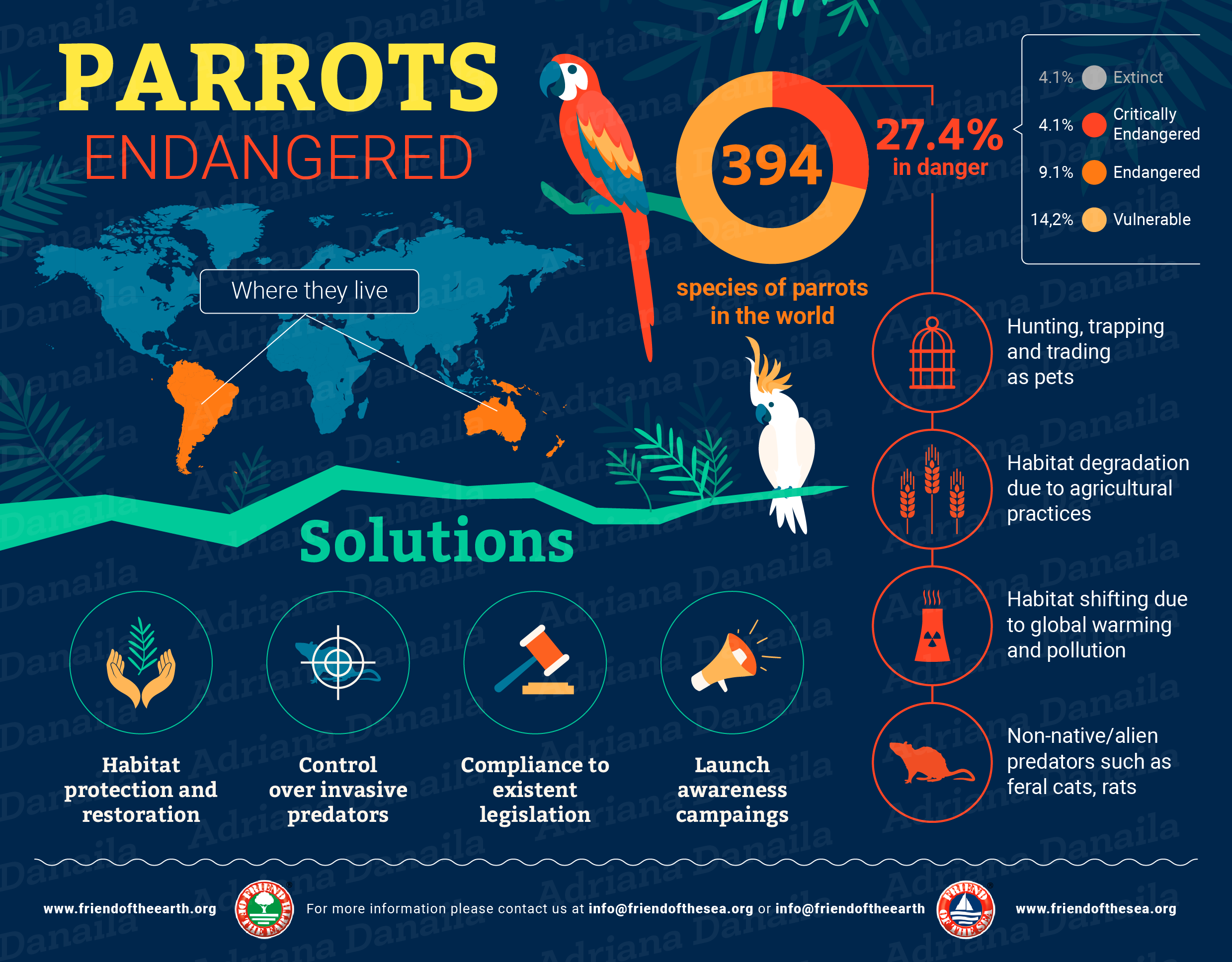Save the Parrots
The Problem
There are 420 species of parrots in the world, mostly terrestrial, found mainly in tropical and sub-tropical regions while several species are inhabitants of the temperate regions. South America and Oceania are the two most biodiverse regions as they are the home of 147 and 129 species respectively. Parrots are considered among the smartest birds, based on human parameters, and they are very popular as pets because they can imitate human voices.
Many factors are contributing towards the declining trend of parrots’ population worldwide much of which is due to human activity.
- The most prominent reason is intentional targeting such as hunting, trapping and trading which threatens highest numbers of the species.
- Habitat degradation due to agricultural practices is the next major concern, which include matters such as small holder farming, agro-industry farming, livestock farming and large-scale harvest.
- In addition, pollution, natural calamities such as tornado, cyclone etc. are disrupting their natural habitats as well as have unbearable consequences on their food sources.
- Industrialization and urbanization also contribute towards habitat shifting. For instance, many parrots dwell in centuries old trees in Australia as they are cavity nesters, but they are losing the nesting sites due to tree logging or by hard competition from introduced species.
- Moreover, they are being predated by non-native/alien species such as feral cats, rats in the ecosystems such as islands because they do not have much anti-predatory behaviors to protect themselves whereas some species such as Cape Parrot are declining due to a virus known as Psittacine Beak and Feather Disease (PBFD).

Environmental Consequences
Many of the parrot species are currently in decline. According to latest IUCN data, 235 species are decreasing in numbers. Among these, 91 species are from South America and South and Southeast Asia ( 68 species). Countries such as Brazil(54), Indonesia(41), Colombia(38), Venezuela(34) and Peru(33) are also natural habitats for these declining populations.
Among all the species, 8.6% and 4.8% of the parrot species are categorized as endangered and critically endangered respectively while 14.5% are considered vulnerable. Unfortunately, 3.8% of these beautiful birds already became extinct with major areas of concern are Sub-Saharan Africa and Caribbean Islands.
In addition, twenty species of parrots are critically endangered and might become extinct soon. Three of them are particularly endangered and could be saved by stopping their trade as pets and protecting them locally
Possible Solutions
It is imperative that their existing natural habitats need to be protected where they can breed and propagate adequately. To this end, it is needed to keep in mind that agricultural practices and industrialization should not be carried out at the cost of significant damage to these endangered species.
Habitat restoration where damage has already been done also remains essential. Vulnerable species situated in protected areas must be inspected to ensure their proper management.
Invasive species which are likely to predate on parrots need to also be controlled.
Ex-situ conservation such as captive breeding/artificial propagation in places such as zoos is essential.
CITES resolutions needs to be implemented properly.
Prevent hunting and trade for pets.
Animal Welfare and better regulations for mass-breeding bird facilities. Eggs are often taken from their parents. Chicks often miss the appropriate care, are fed by inexperienced people causing illness and even starvation.
Last but not the least, raising awareness by working with media, academic institutions, conservation groups, civil society and governmental institutions could save many of the currently threatened parrot species from becoming extinct.
WSF Activities and initiatives
WSO Friend of the Earth project’s activities are focusing on the following:
- Working with local farmers and agricultural/horticultural industries to ensure that the nearby threatended parrot species are protected by relevant practices such as not expanding farm land by cutting out trees where these species live.
- Toxic substances such as pesticides, herbicides, chemical fertilizer usage need to be prevented by working with relevant farm owners and ensure that sustainable farming practices are in place.
- Killing of endangered and nearby endangered parrot species as agricultural pests needs to be avoided which can be done by working together with local law enforcement authorities and legislators.
- Various seminars can be organized in order to raise awareness in the local community so that people understand the importance of parrots in the ecosystem and become vigilante against their persecution and illegal trading.
- Launch campaign on protection of threatened parrot species in change.org.
Call to action
- Elect members of parliament who are concerned about ecosystem sustainability inclyding protection of threatened parrot species and would introduce legislations accordingly when in power.
- Purchase from manufacturers who follow environmental friendly processes to protect parrots. Choose Friend of the Earth certified products.
- Divest from companies which follow practices that are causing further damage to endangered and critically endangered parrot species.
- Promote the establishing of ex-situ conservation as well as national conservation park in countries such as those from Latin America and Indonesia which tops currently in having large number of decreasing species.
- Promote funding by government/other authorities on research related to conservation biology, habitat restoration and pathogenomics of parrots.
- Don't buy Parrots









